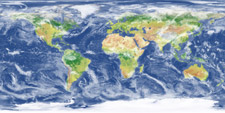
(A basic guide to a complicated subject)
Last year, that wet year of 2012, one subject was on everyone's lips and has been cited as the main reason for all the diabolical weather we have experienced – the Jet Stream. I am sure that many people (including myself) talk about it without understanding exactly what it is, or what it is responsible for, so here are a few basic facts to help the uninitiated understand a little about this highly complex subject.
What is a jet stream?
Jet streams consist of narrow, fast flowing air currents in the upper levels of the atmosphere (at around 30,000ft or 9km). They mainly follow the boundaries between hot and cold air and on Earth they tend usually to flow from west to east at a speed of around 100 mph. Their routes may take an indirect course, starting and stopping, splitting into two, combining into one stream, or even flowing in different directions within the one stream. The strongest streams are the "polar jets" found at around 7-12km above sea level. Above these, at around 10-16km, are the weaker "subtropical jets". The Northern and Southern Hemispheres each have both a polar and a subtropical jet. In the Northern Hemisphere the strong polar jet flows over the middle to northern latitudes of North America, Europe and Asia, while the polar jet of the Southern Hemisphere circles mostly around Antarctica. Seasonal jet streams can also exist, such as the easterly jets which can form in summer in tropical regions of the northern hemisphere and the low level jets which exist in regions of the central United States.
How does it affect us?
In the area of air travel the main relevance of the jet streams will be how they influence flight times, as these can be significantly affected by flying with, or against, the flow of the stream. Air turbulence is another factor which, though it may not change the length of a flight, could certainly affect the comfort. Sailors are more concerned with their influence on the weather, whether they will encounter severe storms, what the wind force will be and naturally whether they can look forward to a lovely sunny day with a good stiff breeze. Meteorologists use the location of jet streams to assist them in weather forecasting and now know that the path of a jet stream can steer cyclonic storm systems at lower levels of the atmosphere and push weather patterns around the world. The presence of the jet stream is also thought to be one of the reasons why most of the Hawaii Islands seem to be resistant to a long list of hurricanes which have approached them and then dissipated before reaching land. Between 1979 and 2001 the jet stream was gradually moving northward across the northern hemisphere, causing drier conditions across the southern tier of the United States and more severe cyclones in the tropics.
What has happened in the UK?
From 2007 to 2012 the jet stream has been moving to an abnormally low latitude across the UK, now lying at around 50°N rather than the more usual 60° N position. As a result, a succession of low pressure weather systems have been dragged across the country instead of being allowed to funnel across to the north while high pressure builds up to the south. These low pressure areas have brought the severe rain and flooding which have devastated many areas of the country.
What causes the jet stream to move?
The simple answer is – no one really knows. As it is formed by differences in temperature between the Poles and the Tropics, any change in those temperatures will have a marked effect on the jet stream. The earth's jet streams can be affected by a phenomenon known as the Southern Oscillation; a see-saw pattern of reversing surface air pressure between the eastern and western tropical Pacific. These cause abnormal warming (called El Nino) and cooling (La Nina). During El Nino California experiences more rainfall as the jet stream moves south and brings more storms with it, while during La Nina California becomes drier and the rain moves into the Pacific Northwest as the jet stream moves south.
Is jet stream movement linked to global warming? Again, no one is sure that climate change is actually influencing the position of the jet stream or whether it is purely due to natural variability. The melting of the ice in the arctic and the gradual warming of the Atlantic may have significant effects on the behaviour of the jet stream, but no one seems to know for sure.
What are the signs for the future?
Unfortunately and as might be expected, the signs are contradictory. While climate models predict drier summers, other research suggests the likelihood of extreme weather. So for all you boat lovers, hope for the best, but be prepared for the worst. It could be yet another wet summer in 2013, so dust off the wellies and make sure your foulies don't leak.
Author – Dee White